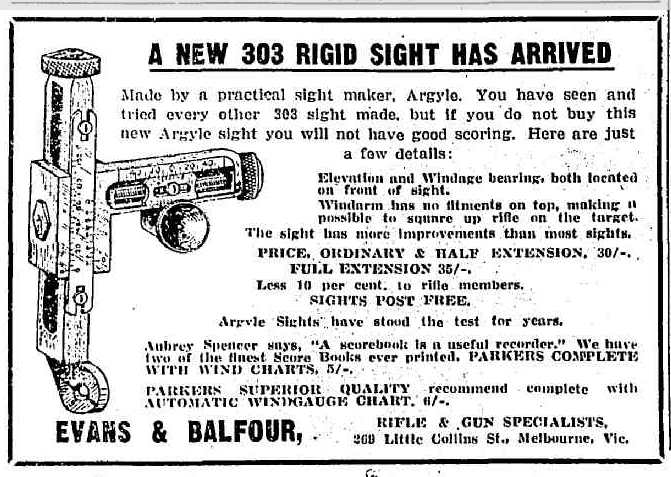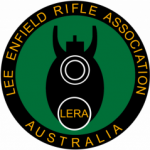(by Aubrey Spencer)
The concluding article by Dr. A. W. L. Row, Toowoomba (Qld.), which appears hereunder, introduces several new features on the scientific aspect of correctly aligning the fore-sight, and best of all, explains in simple terms the reason for certain things which have puzzled even the best marksmen to offer a satisfactory explanation.
Simple as it all may appear, the subject is of the utmost importance, to all who handle fire-arms, and this, with the preceding week’s article, is the first occasion in the history of Australian rifle shooting that anything of its kind has appeared in any publication. Written by a qualified medical man on a highly technical subject involving scientific optical principles; the avoidance of technical terms is striking; This does not rob the subject matter of its importance. If anything, its simplified and explicit terms add to it. Nothing remains to be said except that Dr. Row’s contribution to rifle shooting is indeed a very valuable one. . .
The centreing of the foresight’s tip in the aperture is easy if we remember that the’ only’ time the foresight’s tip can be clearly focused is when it is in the centre of the aperture, or very close to it, for the further it wanders from the centre, the more blurred it becomes (owing to diffraction phenomena intervening around the edge of the aperture). If the foresight does look blurred, either it is not in the centre of the aperture, or else it is not being focused upon by the eye; to determine which, first centre it by a conscious effort, and then try again to focus it sharply; if it is still blurred (and presuming that the aperture is not dirty or shining), then the eye’s power of focusing is at fault; this may be due merely to fatigue, or to a need for spectacles (or occasionally to disease).

FIRING ‘FROM MEMORY’
It is important’ to realise that the eye can be looking at the foresight without the attention being critically directed to it, the attention having been diverted from it by some distraction; in such a case, we often fire ‘from memory’ of what our aim was when last we attended to it, and, although, a good shot may result, one more often gets a bad one, and, most important, cannot guess why! If a marksman cannot tell his coach exactly where the foresight was pointing at the moment of firing, and that he was seeing it sharply focused, then he was not attending to it and focusing it as he should have been, and his shooting will be irregular, no matter how well he is holding and trigger-pressing.
A good marksman with a good rifle, when seeing his foresight clearly until after the shot is gone, can nominate his shot within a few inches on the target, both for line and elevation certainly within the limits of the bull, and sometimes within the central, provided changes in wind or light do not affect it; his object should be to keep seeing the foresight sharply till after the recoil- ‘to see through the recoil.’
OVER OPEN SIGHTS .
Note that aiming over open sights is equivalent to aiming; through an aperture the size of the pupil of the eye, as far as clear definition of foresight and aiming, mark are concerned ; the pupil, being about one-eighth of an inch in diameter, is equivalent to an aperture 12½ /100 of an inch, i.e. a No. 12 approximately; this accounts for the fact that, when the foresight is. Focused upon, the aiming mark looks much more blurred over open sights than through the usual size of aperture, e.g. Nos. 5 or 6.
It is very difficult at first to train the eye to ignore the blurring of the aiming mark when the foresight is focused. In practice, the eye alternately focuses aiming mark and foresight while alignment is being secured but the vital point is to be sure that it is the foresight which is being focused at the moment of firing.
Particularly difficult is such control when any fatigue, mental or physical, is present; such fatigue is most easily detected by a little snapping practice, which also shows if it is the trigger pressing which is disturbing the aim. If the marksman cannot describe exactly where his foresight was pointing while he was firing, then he was not concentrating on the sharp focusing of the foresight.
Let us now consider what distracting influences can cause the attention to wander from the task of sharply focusing the foresight at the moment of firing.
1: Until, by dint of much snapping practice, smooth trigger pressing has become automatic and . almost sub-conscious, the attention is liable to wander, from the sight of the foresight to the feel of the trigger-pressing, we fire ‘from memory’ of where the sight was pointing when we began to press the trigger. This is particularly liable to occur if the trigger is working at all unevenly or too lightly.
2: The thought of the recoil, fearing either unsteadiness or an actual bruise on shoulder or . jaw or cheek, is a very probable distraction until perfect holding has been learnt.
3: The sound of a neighbour’s shot is a very powerful distraction, so much so that we often fire immediately in spite of our desire not to do so, and a bad shot almost always results. Any other decisive or unpleasant sound acts similarly, and in such a case the firer truthfully says ‘I do not know where that one went to’. In other words, he cannot remember where his foresight was pointing when the rifle “went off” because his attention was concentrated on the distracting sound
4: Any discomfort of body or of vision must be rectified, e.g. uncomfortable elbow positions, too tight a sling, an aching left hand due to too tight a pressure on the fore-end, a buckle pressing into a tender spot, sidelight shining into the eyes, wind blowing into the eyes or chilling the legs, an uncomfortable mound, a buzzing fly or mosquito, sweat on the forehead or palms of the hands, any discomfort of one’s stomach like extreme emptiness, or fullness or indigestion, the close-proximity of an unwelcome onlooker, the anxiety of a competition, the quivering of the left eyelid or cheek which warns us of too much mental tension. Not only should we rectify such a distraction before attempting to fire, but we should then pause sufficiently to recover our poise and steadiness before letting the shot go. Especially with emotional upsets, a few slow, deep breaths and closing the eyes for a few seconds will calm us down wonderfully.

OTHER IMPORTANT FACTORS
Fatigue, especially mental or visual fatigue, has a devastating effect upon one’s power of concentrating the attention upon the aim, as shown , by increasing difficulty in nominating the position of the shot. It should especially be remembered how rapidly visual fatigue sets in after even a few seconds of concentrated focusing; in such a case, it is fatal to ‘ let the shot go’ rather should one lower the rifle, rest the eyes for, say, half a minute,’ and then aim again.
Eye fatigue, then, can cause faulty aim in two ways:
1. Failure to keep the eye focused sufficiently long.
2. Failure to focus on the right object.
Shooting in a bad light is particularly liable to cause us to neglect focusing the foresight, for we try hard to see the aiming mark more brightly, and, in doing so, focus upon it instead of keeping the eye focused on the foresight while firing. It must be emphasised that the recoil will mask faulty trigger pressing in most cases; – snapping practice, however, will reveal it, for then the tip of the foresight should not even quiver, much less move off the aiming mark when the trigger is pressed. It is interesting to note in this connection that a marksman, usually will find that he can snap more accurately at one time of day than another- valuable knowledge before going to a big meeting.To avoid fatigue as much as possible, one should aim at an economy of effort, mental and physical- just long enough aiming to ensure accuracy, just firm enough holding to ensure steadiness, just keen enough interest to avoid carelessness, and complete relaxation between shots. This needs much practice

